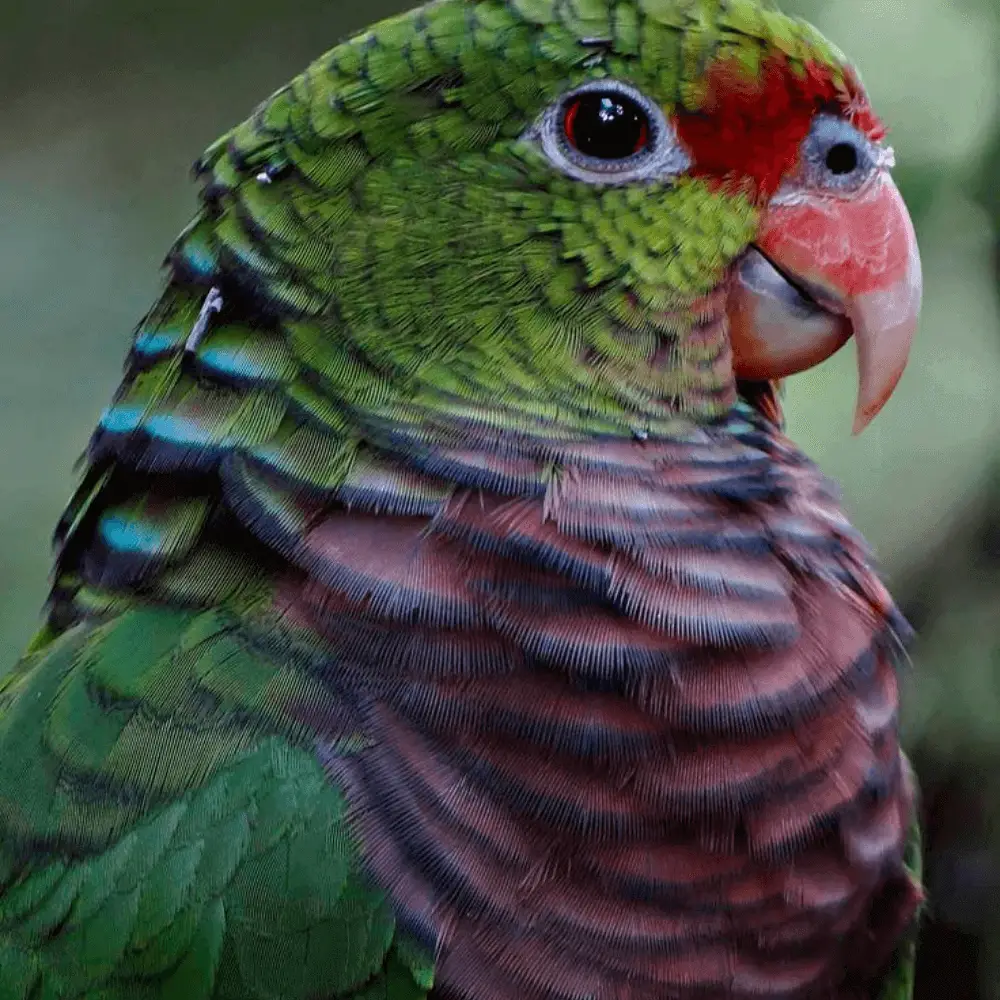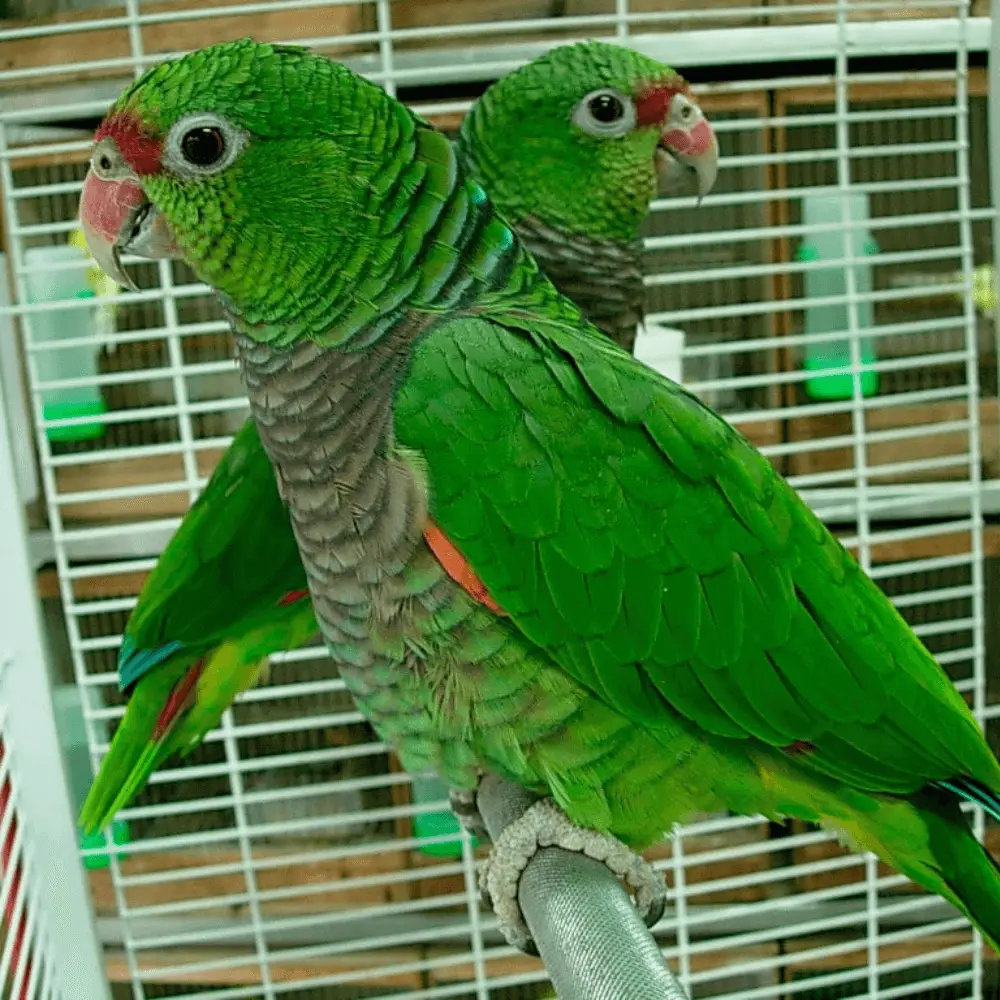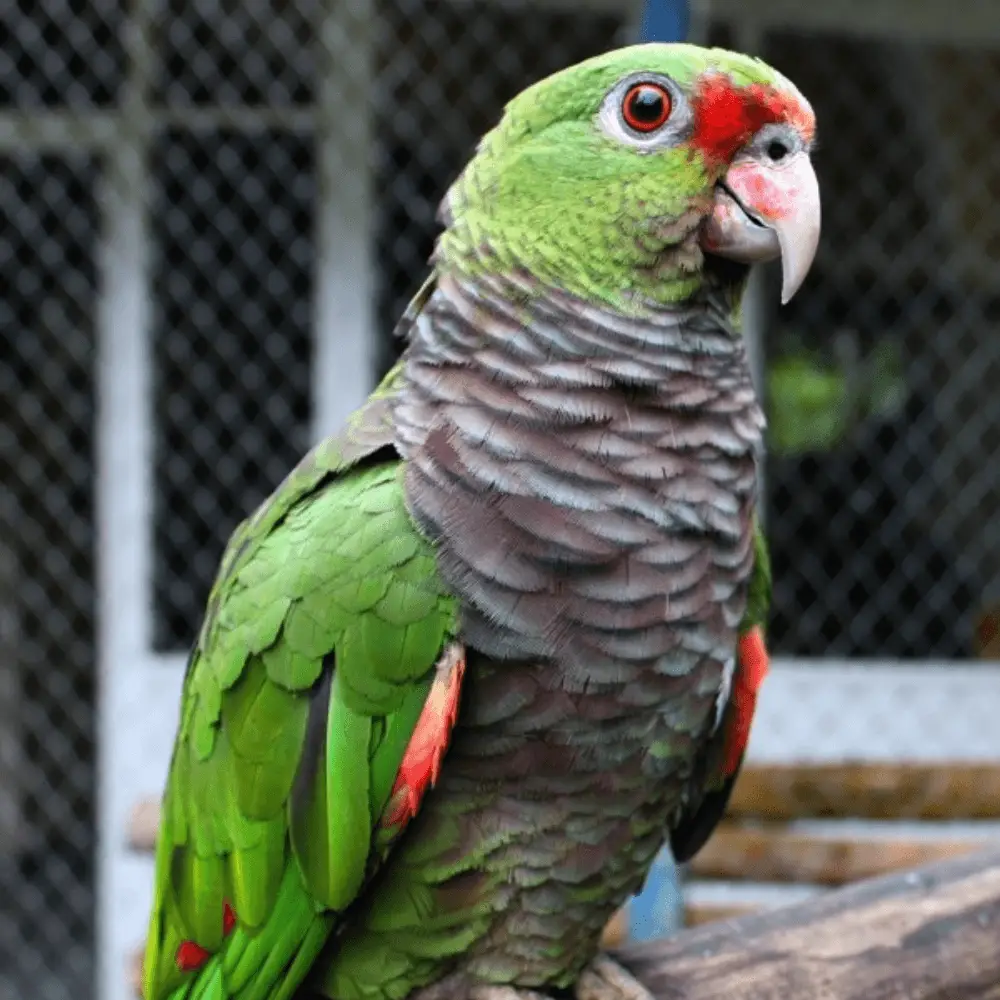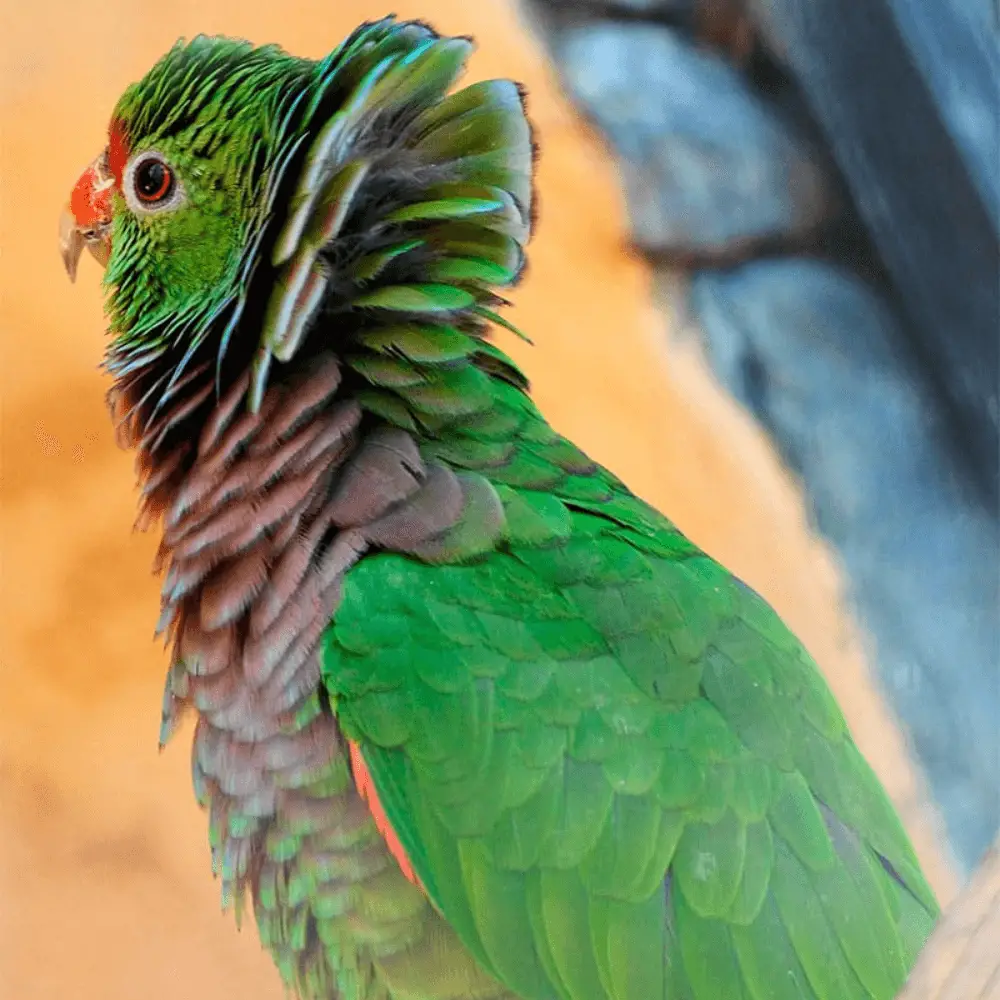Vinaceous-breasted amazon: (Amazona vinacea) has the Yes bright red front lores; cheeks Yes crown green with black tips to a few head feathers; elongated feathers on sides of the neck, nape, and upper mantle, green at the base, blue tip, and subterminal light black. The rest of the mantle, back yes collars, green with some feathers showing indistinct black tips; upper tail-coverts pale green.
wing coverts green with variable red and/or yellow, front edge of the wing and carpal area. Blue-green blade primer; Green secondary with blue tips, the base external networks of the three external secondary, Red, forming a small mirror. Under the Wings, Green.
Throat Yes chest with nuances that vary from intense wine brown to pale blue with a strong vinous diffusion; subterminal black band at the end of the feathers gives an indentation pattern; Bellygreen or yellowish-green sometimes with vinous diffusion; under tail-coverts yellow-green.
Yellow green tail with green tip; the base secondary feathers in red internal networks, in purple external networks. The upper jaw is red at the base with the tip pale, lower color horn, reddish at the base; orange to reddish-brown irises; gray legs.
Both sexes are similar. The immature One has the chest green suffusion and less extensive red on the head (confined to the upper jaw base ).
- Brazil, Argentina, Paraguay
- Longevity: 50 years.
- Height: 30cm.
- Order : Psittaciformes
- Family: Psittacidae
- Genus : Amazona
- Scientific name: Amazona vinacea
- Citation: ( Kuhl, 1820)
- Protonimo: psittacus vinaceus
Habitat

The Vinaceous-breasted amazon dwells in tropical and subtropical mixed evergreen forests; in Brazil in the humid coastal forests, in the east of Paraguay They can be found in the forests Araucaria angustifolia Yes Euterpe edulis.
The extent of this species’ ecological dependence on conifers ( Araucaria Yes Podocorpus ) is unclear, but Araucaria angustifolia is clearly important in Missions, Rio Grande do Sul Yes Santa Catarina and possibly it was related to the earlier distribution further north in southern Brazil.
Primarily sighted in the plains, but there are reports of birds being seen in the hills 1,500-2,000 meters southeast of Brazil, where the best remnants of forests persist. Usually in pairs or small groups with larger meetings (up to about 30) in July-August.
Reproduction

Vinaceous-breasted amazon nests in holes in tall trees, with an obvious preference for the Araucaria angustifolia, rarely including cracks in cliffs. May itself reproduce in loose colonies. the mating season during the months of September to January. Clutch 2-4 eggs.
After the breeding season (February to July), the species congregate in large groups and communal shelters.
Food
The specific foods of the Vinaceous-breasted Amazon include flowers Yes fruits of Euterpe edulis (which apparently is seasonally important in eastern Paraguay ), seeds of Araucaria angustifolia, cocoon fruits of Achatocarpus and new Eucalyptus leaves Yes seeds of Pilocarpus. Damage or cause has been reported in orange crops, but with the low current density of this species, it is unlikely to have a serious economic impact.
Distribution and status

The Vinaceous-breasted amazon is endemic to southern South America.
In Brazil, It has been found in the South Bay, in West Espirito Santo, and scattered localities like Minas Gerais, Brazil (a peripheral record of the Sao Francisco River, subject Januaria ), sporadically in Rio de Janeiro (possibly a seasonal visitor), but widely observed in São Paulo, Paraná, Santa Catarina Y Rio Grande do Sul.
Records in East Paraguay come from Amambay, Canindeyú, Caaguazú, Alto Paraná, Itapua Yes Guaira, and in northern Argentina from Missions and possibly the eastern half of Courants.
There is some seasonal movement and post-breeding dispersal, possibly related to food supply (e.g. seed availability in coniferous trees ), with scale invasions reported in Paraguay in the past. Declining bird numbers in Rio Grande do Sul occur in January, with all of its people gone in March and returning in April for the rest of the year.
Once abundant and widespread but now there has been a dramatic contraction in its range and population, mainly attributable to scale habitat destruction, the expansion of agriculture, and flooding caused by large hydroelectric dams. also ensnared for a long time for the bird trade.
Are distributed in several protected areas, but none are large enough to maintain a viable population. The old strongholds in eastern Paraguay are subject to rapid deforestation, with a recent reduction in their range and numbers, and are now probably confined only to Alto Paraná Yes Ganindeyu.
Probably (or nearly) extinct in Bahia Y Espirito Santo, and a few birds are likely to remain in Rio de Janeiro Y Minas Gerais, Brazil. Confined to the north and northeast of Santa Catarina and locally common only in forested parts of São Paulo Oui Paraná, where the remnant population is thought to survive. Persist in the north and northeast of Rio Grande do Sul.
SOURCE: Loro Parque
Endangered

• Current IUCN: Endangered.
• Demographic trend: Degressive.
• Population size: 600-1700.
The Rationale for Red List Category
This species is classified as endangered due to recent population estimates in Brazil They indicate that the world population is very low and has suffered a rapid decline due to habitat loss and fragmentation, exacerbated by trade. It is necessary to clarify if the Brazilian subpopulations exceed 250 copies.
According to estimates 1.500 2.000 individuals in Brazil ( G. In some Bencke. 2009 ), 220-400 in Paraguay Yes 253 in Argentina ( K. In some soapwort. 2009 ), It is estimated that the total population is located in the range of 1,970 -2,650 individuals and is probably placed inside the 1,000-2,499 band. This is equivalent to 667-1,666 mature individuals, rounded here to 600-1,700 mature individuals.
Rapid and continuing population decline is suspected due to illegal hunting of nests, habitat destruction, and persecution as a crop pest.
Vinaceous amazon in captivity
The Vinaceous-breasted Amazon is noted for its easy-to-imitate human voice, better and clearer than the Amazona aestiva. Small easily they learn to speak.
Two decades ago, prior to placement in the Appendix 1 CITES Convention, this species was available in aviculture. It was never imported to Europe in large numbers, but nonetheless often offered for sale.
Its price was higher than other species of Amazona available at that time, due to its amazing looks and talent as an imitator. As the wild bird trade came to an end, the captive population declined markedly.
Although this species has been willing to breed for those who provide adequate breeding and have enough individuals to allow natural mate selection, captive breeding has been very disappointing., given the number of birds that were previously available.
In the. avicultura, it seems that there are still a significant number of birds kept in Europe. A survey of Amazon parrots in European zoos, made in 1993 and published in 1994 by EAZA, listed 59 vinous Amazon species kept in 11 zoological collections:
these, only three, Loro Parque ( Spain ), Walsrode Bird Park ( Germany ) Yes Beauval ( France ), had recorded breeding successes. It is known, however, that a significant number of vinous AmazonThey are owned by private poultry farmers in Europe, and if those owners are willing to work in cooperation with any EEP plan that may be initiated for this species, then the known captive population in Europe could be large enough to be considered a workable solution.
The population of this species in captivity is similar to that of other species in the genus Amazona. In Loro Parque, one pair is kept in an aviary in the park’s display area, and several other pairs are kept in hanging breeding cages in their outdoor display breeding.
Hanging breeding cages are approximately 300cm in length x 95cm in width and height. Each cage has the nest box placed against the outer back wall, and there is a cut in the wire hole so that the birds can enter the nest box. His nest is located outside the cage, eliminating the need for a birdhouse.
The food of these birds is done twice a day. At the 7 Morning receive their main course containing a salad prepared with the following: – Apple, PEAR, tomato, beetroot, carrot, alfalfa, lettuce, peppers, papaya, and other fruits and vegetables available in season;
In addition, They are also used, when available, for various fruits that are grown in the park, such as plants and berries of cactus nopal palmera Pindo (Syagrus romanzoffiana). A second smaller meal dish in the morning provides a commercial pellet parrots diet, and during the breeding season, each pair also receives segments of their own “pastel” supplement which is fresh daily. The evening meal is given at 3:00 PM, with a mixture of nuts, seeds, and cooked beans.
The Vinaceous Amazon She was first raised in Loro Parque in 1990 when a pigeon was raised by hand. The couple proved to be very reliable when it came to incubating their eggs, why they always resorted to artificial incubation or fostering and rearing.
This couple of Vinaceous amazon has received eggs from more common species on subsequent occasions to give them the opportunity to prove that they are good parents, but so far they remain unreliable.
In 1993, when the same pair joined again, the clutch of eggs was transferred to a pair of Green-cheeked Parrot (Amazona viridigenalis), where they proved to be excellent foster parents and the reared chicks were born. The same technique was used in 1994, but only one egg clutch proved to be fertile and the chick was successfully raised by Green-cheeked Parrot.
Related article:

